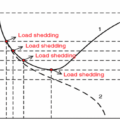Before discussing how hydroelectricity is Generated by Dams in 4 steps through 2022, we will have to understand briefly what is meant by a Dam.
A dam Is a type of human-made structure that is built across any river for the purpose of holding water back.
Dams have been made and constructed from a long time back which dates to several centuries before, that time obviously there were not much advent of technology and people used to construct it simply by rocks and even clays. Today, dams are constructed using RCC and other materials. Dams not only help in storing water but also help in irrigation purposes also for industrial uses, but the most prominent use of dams is to store water which is ultimately used for the production of electricity.
The production of electricity from a dam is quite a complex process and there are many processes and inter processes related to it. The dam turns potential energy held in a water reservoir behind the dam into mechanical energy, which is also known as “kinetic energy.”.
The largest hydroelectric dam that makes electricity in the world—the Three Gorges Dam in China’s Yangtze River—can generate up to 22,500 MW of electricity.
How Do Hydroelectric Dams Generate Electricity?
Step1: Harnessing Potential Energy
A flowing river releases potential energy in the form of kinetic energy and sound—gravity forces water to flow in a specific direction. Dams halt the release of kinetic energy and effectively store the potential energy of a river in a lake-like reservoir. Hydroelectric dams work by “reserving” a river’s water and potential energy. The hydraulic head, which is created by the depth of the water and the velocity of the water as it travels through the dam’s penstock, drives the turbine in the hydroelectric plant.
Step2: Turning the Hydroelectric Turbine
Mechanical fans vary in shape and size Generally speaking, the larger the fan, the harder it is to move it. Large fans require higher voltages and bigger motors to spin them. Large turbines, such as the Francis turbines in Three Gorges and many other hydroelectric dams also require more energy to accelerate their movement. The hydrostatic pressure created by the dam’s potential energy creates this hydraulic head, which increases as the fluid’s velocity grows. As the turbine spin, the hydraulic head converts into kinetic energy. This conversion effectively eliminates the water’s velocity and hydrostatic pressure, allowing it to flow out slowly from the base of the dam.
Step3: The Hydroelectric Turbine Generator
The turbine’s rotational motion generates electrical energy. Turbines are either directly or indirectly coupled with electrical generators via a gearbox or transmission that spins the shaft and the generator’s armature.

Step4: Capturing and Transmitting Hydroelectric Power generated by dams
Generated electricity quickly transforms into grid-level voltages, which the local power company then transmits via power lines. The step-up transformers in hydroelectric dams create utility-scale voltages from relatively lower generator output voltages. The higher voltages that exit a hydroelectric power plant are ideal for long-distance power transmission, given the low electrical current that makes them more efficient.
Massive generates, such as those at work in hydroelectric dams, create a significant amount of opposing the passage of magnetic flux lines, especially at dams, that can only be overcome by torque forces that are strong enough. Using a transmission system like the one in a car, the turbine’s rotational motion converts into varying torque and speed ratios. This is how a generation of electricity by means of a dam takes place.
Written by: Falak
Keep following GoTechies for more !!

